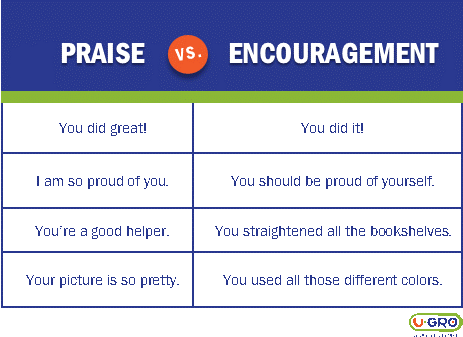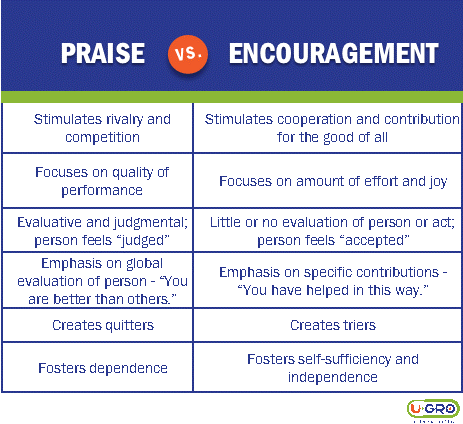- 855.224.8655
- Schedule a Tour

Encouragement is essential to building a child’s confidence and self-esteem. Many parents may understand the importance of encouraging children, but they may confuse encouragement with praise. What may seem like an encouragement could in fact be praise. In this blog post, we explain the differences between praise and encouragement.
What are the differences between encouragement and praise?
Again, the two concepts can easily be mistaken for each other without even realizing it. Praise tends to focus on judgments, which in turn can lead to anxiety or pressure to manage expectations.
- Praise often comes paired with a judgment or evaluation, such as “best” or “good.” This type of praise automatically creates a comparison with others. It’s a value judgment, which can teach children to measure their success based on another person’s idea of what makes something valuable.
- Evaluative praise can create anxiety, invite dependency, or evoke defensiveness. For example, a child who is always told that his or her artwork is beautiful may not know how to respond to other types of feedback.
- Praise can reinforce children to “perform” for what they think others expect of them, rather than for their own satisfaction. A child who is always seeking praise from others may never stop to think about what is important to her. He or she may base all of her goals on the expectations of others.
Encouragement statements, on the other hand, focus on acknowledging the child’s capabilities. This type of statement should inspire rather than tell.
- Encouragement statements are based on descriptive feedback. If a child completes a puzzle that was a bit challenging, try to avoid saying, “Good job!” She might think that completing a puzzle is a good thing to do and that she should keep doing more puzzles. However, think about how the interaction changes when you use specific encouragement. You could say something like, “You finished the puzzle, even though it was a little bit tricky! You kept trying until you figured it out.” The message here is about perseverance, not about puzzles, and this child can now apply that concept to other situations.
- Encouragement allows children to become self-motivated. Using the same artwork example, a statement of encouragement would be something like, “Look how many colors you used!” It focuses on the individual’s actions/effort. The remark about the range of colors acknowledges the child’s work and creativity, and may get him or her thinking about the use of color in art. In turn, this could motivate him to experiment more.

Why is it important to encourage children?
It can be a challenge to get into the habit of turning our statements of praise into comments of encouragement. Praise is much more immediate than encouragement, so it can be easy to fall into the habit of using praise statements.
When we stop ourselves from falling back on simple phrases like, “Good job!” and think about how to say it more meaningfully in specific terms, we become encouragers. The encouragement not only benefits our young learners, but us as well. Children gain a clear understanding of what, and how, they are doing based on specific feedback.

Once children learn that qualities such as perseverance and effort are valuable, they begin to incorporate these qualities into their daily life. Your continued encouragement can help your children to develop a habit of positive self-talk, leading to greater self-regulation in the long run.
U-GRO’s Blended Model® curriculum’s focus on the whole child requires that we consider the differences between praise and encouragement (both at home and in the classroom) as we work together to support our children’s growing self-esteem and the development of self-regulation skills.
